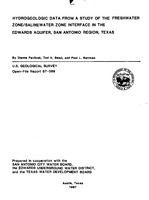Hydrogeologic data from a study of the freshwater zone/salinewater zone interface in the Edwards Aquifer, San Antonio region, Texas
Links
- Document: Report (pdf)
- Download citation as: RIS | Dublin Core
Abstract
The highly productive freshwater zone of the Edwards aquifer in the San Antonio region (fig. 1) is the sole-source water supply for more than 1 million people. A transitional interface exists between the freshwater zone and the downdip, salinewater zone. A 1,000 mg/L (milligrams per liter) dissolved solids-concentration contour defines an arbitrary boundary -between the freshwater zone and the salinewater zone. Locally, the 1,000 mg/L dissolved solids-concentration contour is referred to as the "bad-water" line. Salinewater intrusion into the freshwater zone is hydraulically possible. Lower than-average water levels in the Edwards aquifer could reverse hydraulic gradients and cause intrusion. Drought conditions, lower-than-average recharge, and increased ground-water withdrawals are factors which lower ground-water levels.
The purpose of this study is to assess the potential for salinewater intrusion into the freshwater zone. The purpose of this report is to present hydrogeologic data collected during the test drilling and initial testing phase of the study. Information regarding flow tests, water quality, geophysical logs, and lithology are provided in this report. The study was conducted by the U.S. Geological Survey in cooperation with the San Antonio City Water Board, the Edwards Underground Water District, and the Texas Water Development Board.
| Publication type | Report |
|---|---|
| Publication Subtype | USGS Numbered Series |
| Title | Hydrogeologic data from a study of the freshwater zone/salinewater zone interface in the Edwards Aquifer, San Antonio region, Texas |
| Series title | Open-File Report |
| Series number | 87-389 |
| DOI | 10.3133/ofr87389 |
| Year Published | 1987 |
| Language | English |
| Publisher | U.S. Geological Survey |
| Contributing office(s) | Texas Water Science Center |
| Description | v, 108 p. |
| Online Only (Y/N) | N |
| Additional Online Files (Y/N) | N |


